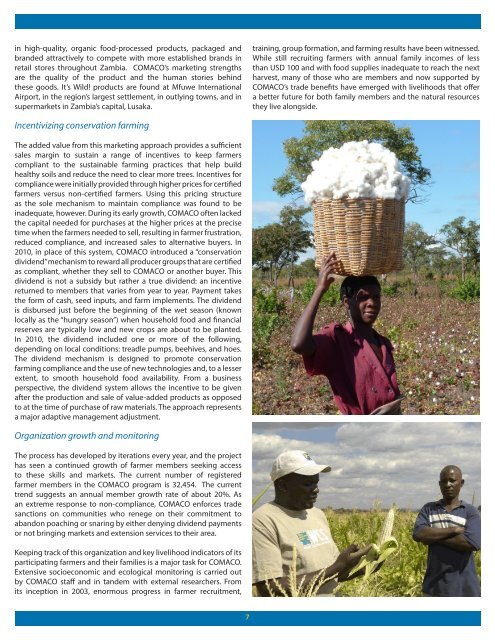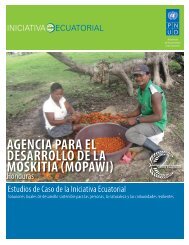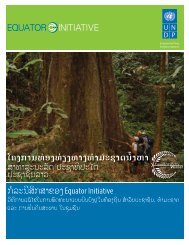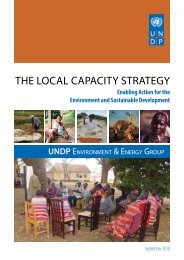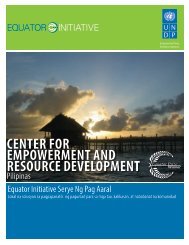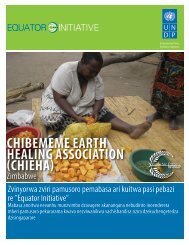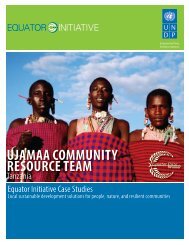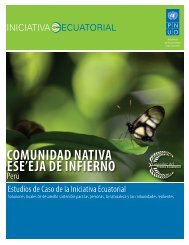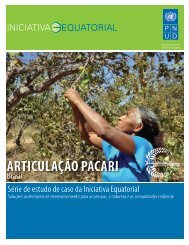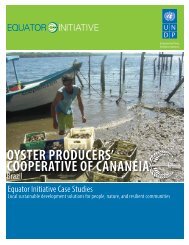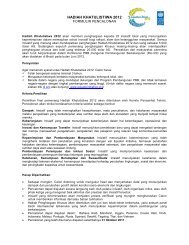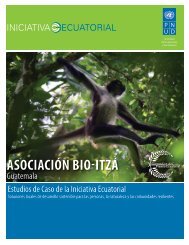Community Markets for Conservation - The GEF Small Grants ...
Community Markets for Conservation - The GEF Small Grants ...
Community Markets for Conservation - The GEF Small Grants ...
- No tags were found...
You also want an ePaper? Increase the reach of your titles
YUMPU automatically turns print PDFs into web optimized ePapers that Google loves.
in high-quality, organic food-processed products, packaged andbranded attractively to compete with more established brands inretail stores throughout Zambia. COMACO’s marketing strengthsare the quality of the product and the human stories behindthese goods. It’s Wild! products are found at Mfuwe InternationalAirport, in the region’s largest settlement, in outlying towns, and insupermarkets in Zambia’s capital, Lusaka.training, group <strong>for</strong>mation, and farming results have been witnessed.While still recruiting farmers with annual family incomes of lessthan USD 100 and with food supplies inadequate to reach the nextharvest, many of those who are members and now supported byCOMACO’s trade benefits have emerged with livelihoods that offera better future <strong>for</strong> both family members and the natural resourcesthey live alongside.Incentivizing conservation farming<strong>The</strong> added value from this marketing approach provides a sufficientsales margin to sustain a range of incentives to keep farmerscompliant to the sustainable farming practices that help buildhealthy soils and reduce the need to clear more trees. Incentives <strong>for</strong>compliance were initially provided through higher prices <strong>for</strong> certifiedfarmers versus non-certified farmers. Using this pricing structureas the sole mechanism to maintain compliance was found to beinadequate, however. During its early growth, COMACO often lackedthe capital needed <strong>for</strong> purchases at the higher prices at the precisetime when the farmers needed to sell, resulting in farmer frustration,reduced compliance, and increased sales to alternative buyers. In2010, in place of this system, COMACO introduced a “conservationdividend” mechanism to reward all producer groups that are certifiedas compliant, whether they sell to COMACO or another buyer. Thisdividend is not a subsidy but rather a true dividend: an incentivereturned to members that varies from year to year. Payment takesthe <strong>for</strong>m of cash, seed inputs, and farm implements. <strong>The</strong> dividendis disbursed just be<strong>for</strong>e the beginning of the wet season (knownlocally as the “hungry season”) when household food and financialreserves are typically low and new crops are about to be planted.In 2010, the dividend included one or more of the following,depending on local conditions: treadle pumps, beehives, and hoes.<strong>The</strong> dividend mechanism is designed to promote conservationfarming compliance and the use of new technologies and, to a lesserextent, to smooth household food availability. From a businessperspective, the dividend system allows the incentive to be givenafter the production and sale of value-added products as opposedto at the time of purchase of raw materials. <strong>The</strong> approach representsa major adaptive management adjustment.Organization growth and monitoring<strong>The</strong> process has developed by iterations every year, and the projecthas seen a continued growth of farmer members seeking accessto these skills and markets. <strong>The</strong> current number of registeredfarmer members in the COMACO program is 32,454. <strong>The</strong> currenttrend suggests an annual member growth rate of about 20%. Asan extreme response to non-compliance, COMACO en<strong>for</strong>ces tradesanctions on communities who renege on their commitment toabandon poaching or snaring by either denying dividend paymentsor not bringing markets and extension services to their area.Keeping track of this organization and key livelihood indicators of itsparticipating farmers and their families is a major task <strong>for</strong> COMACO.Extensive socioeconomic and ecological monitoring is carried outby COMACO staff and in tandem with external researchers. Fromits inception in 2003, enormous progress in farmer recruitment,7


